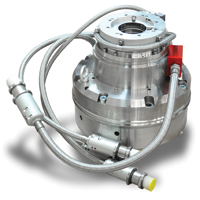
Posted to News on 23rd Apr 2018, 00:00
Magnetic bearings are not just for niche applications
Magnetic bearings were once restricted to niche, expensive applications. However, they are now finding increasing use in general industrial applications as technical advances make them more affordable, as Phil Burge of SKF explains.

Imagine a bearing that has almost no friction and needs no lubricant, so that it’s likely to enjoy a long and healthy life. The good news is that they already exist, in the form of magnetic bearings. The bad news is that because they are engineered with such high precision, they are generally too expensive for most industrial applications.
Magnetic bearings use a cushion of air – rather than lubricant – to minimise friction. They are generally used in safety critical applications where cost concerns are less important, such as the offshore oil and gas sector. As well as extending operating life, the almost complete absence of friction cuts the need for maintenance. These are all important factors for any design engineer to consider when specifying a bearing for rotating machinery.
The good news is that magnetic bearings are becoming more affordable for general industrial applications. Although they are by no means a plug-in solution for all applications across the manufacturing and process sectors, they can, when chosen correctly, be an effective design choice that resolves particular problems, where higher costs can be justified.
Magnetic bearings are complex assemblies. Active magnetic bearings use powerful electromagnets to generate radial and axial forces, levitating a central shaft, so it rotates in a stable position. Using signals from rotor gap measuring sensors, a control system monitors and adjusts the current in the electromagnets to maintain the precise position of the shaft.
Recent technical advances, including algorithm developments, smaller electronics and embedded sensors, are now reducing costs and making magnetic bearings available for much wider use.
One example is SKF’s adaptive vibration control (AVC), which controls the response of the bearing unit to shaft imbalance. This can be used in two ways, each of which offers benefits in particular types of application. Firstly, it can allow a shaft to rotate around its geometric centre, while accurately controlling it to eliminate the run-out caused by imbalance. This feature is of particular benefit in machine tool applications.
Alternatively, the shaft can rotate around its mass centre, which transfers less vibration to the casing. This is highly valued in turbomolecular pumps and front-end semiconductor manufacturing equipment.
Many of the software packages that are used with standard bearings can also be utilised with magnetic bearings, allowing such systems to be commissioned, controlled and monitored with ease. For instance, MBScope helps to speed up the commissioning of a magnetic bearing system. This verifies that the bearing system meets standards such as ISO 14839 (these govern the mechanical vibration of rotating machinery equipped with magnetic bearings), and monitors system health using shaft clearance check and stability analysis. The system also allows remote adjustment and monitoring.
SKF @ptitude Observer also helps to apply rigorous condition monitoring to magnetic bearings, especially for systems ranging from critical turbo-machinery to general purpose equipment. This product connects directly to an E300V2 magnetic bearing control cabinet, processing data directly from it to alert operators of potential impending problems.
Because magnetic bearings are lubricant-free, they are an ideal choice for machines that operate in a vacuum, at high or low (particularly cryogenic) temperatures, or where corrosive process fluids are involved. Any machine with zero tolerance for contamination by lubricants or wear particles, or where the lubricant is incompatible with the process, may be a candidate for a magnetic bearing solution. This could apply to industries as diverse as semiconductor manufacturing systems or food and beverage processing equipment.
While the lubrication-free aspect is perhaps the main benefit of magnetic bearings, there are many others. For example, they offer: near-frictionless operation, thanks to a lack of metal-to-metal contact; high speed, vibration-free operation; high energy efficiency; and in-built condition monitoring. Magnetic bearings also rely on a carefully controlled air gap, and certain applications benefit directly from this, such as where process liquid or material is involved, or in biological and pharmaceutical applications that involve life cell processing. Because magnetic bearings can be hermetically sealed, they are an attractive option for handling corrosive fluids, which would otherwise damage the stator windings or laminations.
They can also be immersed in process fluids under pressure, without the need for seals, so are potentially useful in some of the more sensitive processes in food production.
Thanks to their frictionless nature, magnetic bearings also run at extremely high speeds of up to 250m/s. High-speed bearings have many specialist applications, including advanced machine tool spindles or in specialised laboratory equipment, such as the hydrogen circulators now being used at several US National Laboratories.
In magnetic bearing systems, bearing force can be modulated for deliberate excitation of vibration, the excitation force being applied to the rotor without contact. It can also be measured precisely. In this way, magnetic bearings can provide valuable tools for equipment design, development and testing, as well as rotor dynamic research. The method has been used to test and verify new seal designs, and the performance of machine tool spindles. Additionally, in machine tools, the magnetic bearing control system’s ability to adjust the air gap and change the shaft location – or even to oscillate the shaft – can help to compensate for tool wear in grinding processes.
Although the main use of magnetic bearings will for the foreseeable future continue to be in traditional high-end applications, the advent of new control options now opens up a much wider range of options for design and production engineers to exploit the benefits of these frictionless, high speed solutions.





